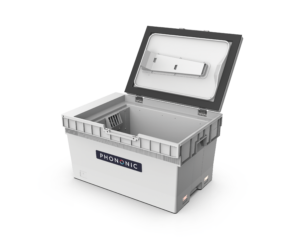Micro fulfillment – the practice of converting existing grocery space into small-scale, automated distribution centers that fulfill online orders — was very much on the radar of the grocery industry as an area that had real potential for increasing revenue, enhancing customer satisfaction and loyalty, and driving innovation in the space.
As early as 2000, initial strategies were being considered by grocers nationwide and a select few – the biggest players in the industry – were already researching the most promising technologies in the search for the optimal system and process. With the world now adapting to completely new health and safety precautions in the monumental race to stop the spread of coronavirus, that search has now reached a level of urgency that very few could have anticipated.
The grocery industry is ramping up at warp speed to manage the explosive growth of this segment. In 2016, online grocery sales were $20 billion; given the pandemic’s urgency and massive behavior change in the space, they are now projected to hit $100 billion this year versus 2025, according to “The Digitally Engaged Food Shopper” report from FMI/Nielsen. As it stands today, the largest concentration of capital resources is in grocery and mass segments. This is not a want, but a must have for grocery, convenience, mass and dollar channels to compete in the space or fail: curbside pickup and last mile delivery is critical to making this a reality.
What would have taken months if not years is now happening in weeks as executives across the space search for solutions to the many challenges inherent in micro fulfillment: expensive, energy-intensive refrigerated / frozen storage spaces; costly retrofits for existing buildings; and the need to build new warehouse space, requiring massive upfront capital. Given the huge current demand by consumers for curbside pickup, speed to market needs to be quick to keep up, yet time to scale is prohibitive. And while expectations for a seamless process are not quite there yet from customers, it will soon be an expected critical element of the shopping experience, once shoppers become accustomed to the service.
Phononic’s thermoelectric cooling technology solves the challenges grocers are now facing as the segment explodes. Phononic’s on-demand, actively cooled refrigerated and frozen containers provide the perfect temperature to cool and freeze curbside and delivery containers, maximize internal volume and maintain cold chain integrity through the entire process.
Simple, scalable and sustainable cooling technology for curbside and the last mile, Phononic’s containers offer unmatched ROI and flexibility for grocers.

Phononic Refrigerated/Frozen Container –
Individual features:
- Strong ROI: Reduce start-up capital and time to market without risking future scale
- Flexible: OPEX and CAPEX based on real time demand; allows for flexibility in scaling as demand fluctuates
- Reduced labor: With improved processes, fulfilment steps can be reduced by as much as 50%
- Increase throughput: By eliminating or reducing touch points, improving process flows and building a fulfillment process not constrained by cooling and freezing needs
- Demand-based energy savings: Cool or freeze only the number of customer orders needed, not an entire cooler or warehouse
- Versatile: One common system solves multiple use cases: Curbside (Manual, Semi Automated, Automated); Delivery and Unassisted delivery
- Scalable: Kick off with 10 container or grow to thousands in a single warehouse or back room without free standing refrigerators and freezers, , freezer warehouses or tri-temp trucks
- Capacity: The elimination of the compressor combined with Phononic’s patented technology maximizes internal volume while keeping the container compact
- Location agnostic: Ramp up for any space: Large grocery, club, small market, discount store or fully automated warehouse
- Maintain documented cold chain/IOT: Temperature is monitored by an IOT system to document cold chain, reducing errors and keeping customers’ complete orders together (including ambient and chilled products)
With Phononic’s refrigerated/frozen containers, the entry cost is low while the ability to scale is limitless. Grocers can build to today’s capacity, yet the system’s modular design allows for flexibility in growth without the heavy upfront cost needed to build large spaces to chill and freeze. Expanding capacity is also easy to do and requires little space with vertical storage.
Energy is real-time demand driven: grocers cool only the order that is needed and can maintain cold chain documentation without manual labor. There can be increased storage in the same footprint. Since the totes are actively cooled and frozen, they can be stored on standard racks or (to increase space even further) high carousel racks that utilizing vertical space versus expensive square footage in the back of the store or elsewhere.
Phononic’s on-demand cooling technology also helps to decrease the labor cost – reducing cold item process flow by as much as 66%.
Picking time is reduced as the customer’s chilled and frozen groceries are only touched once versus multiple times in the current system. Order fulfillment and errors are vastly reduced as all chilled ad frozen items would be placed in one location and touched once – the associate managing the picking goes to just one location to find the order.
Finally, since the containers are chilled or frozen, the entire customer order can be staged at the door or pickup window when the customer is on the way, versus waiting for the customer to arrive. Given the stable, sustained cold temperature, an associate can also pull orders anytime day or night, off peak if needed, to reduce rush hour and overtime. Over time, these improvements will drastically reduce overall labor time and ultimately help associates deliver a much more seamless experience both for customers and for their own teams.
This is true on-demand mobile cooling for grocery, just in time. To learn more, contact us at [email protected].
View the Product Sales Sheet here: https://phononic.com/resources/phononic-micro-fulfillment-sales-sheet/